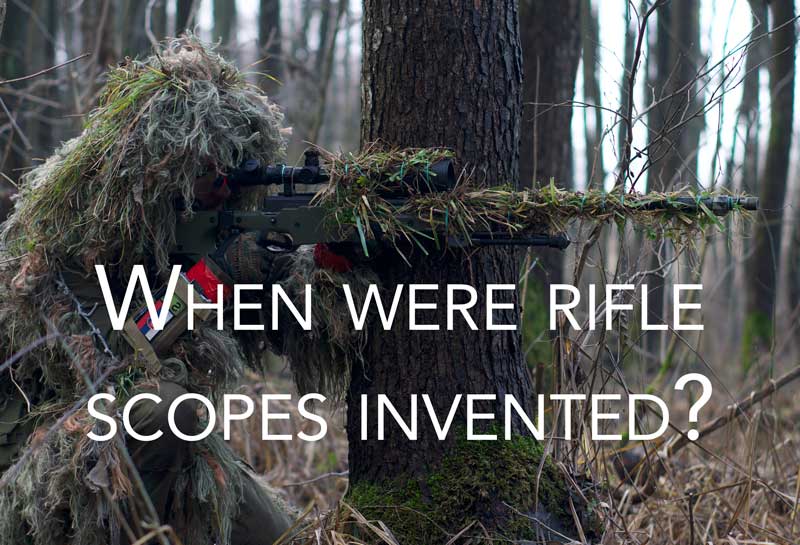
Welcome to our exploration of the fascinating history and evolution of rifle scopes.
We’ll uncover the early experiments and breakthroughs that led to their invention, from William Gascoigne’s clever use of a spider’s web to John R. Chapman and Morgan James’ creation of the first telescopic rifle sight.
We’ll also delve into the different types and applications of these scopes, as well as their components and functionalities.
Get ready to be liberated by the rich history and advancements of rifle scopes.
Let’s dive in!
Key Takeaways
- Early experiments with optical aiming aids and primitive predecessors of telescopic sights
- Invention of the first documented telescopic rifle sight by John R. Chapman and Morgan James
- Telescopic sights widely used on rifles, particularly long-barrel firearms
- Prismatic sights are lighter and more compact than conventional telescopic sights
Early Experiments and Discoveries in Aiming Technology
We have discovered that early experiments in aiming technology led to significant advancements in telescopic sights. In our quest for liberation, we delve into the rich history of aiming aids and optical advancements that paved the way for the incredible telescopic technology we have today.
One of the most intriguing early experiments involved using a spider’s web in a telescope for aiming. William Gascoigne, a 17th-century astronomer, discovered that a spider’s web could be used as a crosshair-like reference point in a telescope. This simple yet ingenious idea laid the foundation for the development of more sophisticated aiming aids.
Over time, inventors and visionaries like Charles Willson Peale, David Rittenhouse, James Lind, and Captain Alexander Blair built upon these early experiments, describing guns with telescopic sights and even mounting telescopes to rifles. These pioneers set the stage for the invention of the first documented telescopic rifle sight by John R. Chapman and Morgan James.
The advancements in telescopic technology that emerged from these early experiments revolutionized the world of aiming. Today, we benefit from telescopic sights equipped with reticles, mounted in focal positions for accurate aiming. These sights aren’t only used on long-barrel firearms but also on platforms such as artillery, tanks, and aircraft.
As we explore the history of telescopic sights, we gain a deeper appreciation for the optical advancements that have empowered us with reliable visual aiming and magnification. The spider’s web may have been the starting point, but it’s the tireless efforts of innovators throughout history that have set us free to aim with precision and clarity.
Collaborations and Breakthroughs in Telescopic Rifle Sight Development
Our team has been actively researching and analyzing the collaborations and breakthroughs in telescopic rifle sight development. We understand the importance of invention collaborations and how they’ve led to optical advancements in aiming aids. The field of telescopic advancements has seen remarkable technological breakthroughs that have revolutionized the way we aim and shoot.
- Invention collaborations: Collaborations between inventors have paved the way for innovative telescopic rifle sights. Through teamwork and shared knowledge, these inventors have created groundbreaking solutions.
- Optical advancements: The continuous improvement in optics has resulted in clearer and more precise aiming aids. Optical innovations have enhanced the accuracy and effectiveness of telescopic sights.
- Aiming aids: Telescopic rifle sights serve as indispensable aiming aids, providing shooters with a clear and magnified view of their targets. These aids have greatly improved target acquisition and accuracy.
- Telescopic advancements: The evolution of telescopic sights has been remarkable, with advancements in design, materials, and technology. These advancements have led to more compact, lightweight, and versatile telescopic sights.
- Technological breakthroughs: The integration of technology into telescopic sights has opened up new possibilities. Features such as reticle illumination, parallax compensation, and smart device compatibility have enhanced the functionality and user experience of telescopic sights.
We believe that the constant pursuit of invention collaborations, optical advancements, aiming aids, telescopic advancements, and technological breakthroughs will continue to liberate shooters, empowering them with the tools they need to achieve their goals with precision and confidence.
The First Documented Telescopic Rifle Sight: Invention and Impact
The invention of the first documented telescopic rifle sight revolutionized the way we aim and shoot, impacting the accuracy and effectiveness of shooters. This groundbreaking innovation in aiming technology has paved the way for numerous milestones and innovations in the field of sight evolution. The impact of this invention can’t be overstated, as it has empowered shooters to take their skills to new heights.
Before the development of telescopic rifle sights, shooters relied on traditional iron sights, which had their limitations in terms of accuracy and precision. However, with the introduction of telescopic sights, shooters gained the ability to magnify their target and achieve a clearer sight picture. This advancement in technology allowed for enhanced accuracy over longer distances, giving shooters a significant advantage on the battlefield or in the field.
The collaborations and breakthroughs in telescopic rifle sight development have led to the creation of various types of sights, each with its own unique features and capabilities. From fixed-power telescopic sights to variable-power scopes with adjustable zoom mechanisms, shooters now have a wide range of options to suit their specific needs and preferences.
Furthermore, the continuous evolution of telescopic rifle sights has led to significant improvements in optical parameters, such as magnification, objective lens diameter, and field of view. These advancements have further enhanced the shooting experience, providing shooters with a clearer and more precise sight picture.
Evolution and Classification of Telescopic Sights
Let’s explore the different generations and advancements in the evolution of telescopic sights.
Telescopic sights have come a long way since their early experiments and discoveries. Here are some key points to consider:
- Different types of reticles: Reticles play a crucial role in aiming accuracy. They come in various styles, such as crosshairs, BDC (bullet drop compensator), and mil-dot. Each type offers unique benefits for different shooting scenarios.
- Advancements in optic coatings: Optical coatings have revolutionized the image quality produced by telescopic sights. Anti-reflective coatings reduce glare and improve contrast, while lens coatings increase light transmission and protect the lens. Modern multi-layer coatings ensure maximum brightness and natural colors.
- Impact of optoelectronics on telescopic sights: The integration of optoelectronics has greatly enhanced the functionality of telescopic sights. Night vision capabilities, smart device compatibility, and reticle illumination are just a few examples of how optoelectronics have expanded the capabilities of these sights.
- Benefits of prismatic sights: Prismatic sights offer a lighter and more compact alternative to conventional telescopic sights. They utilize a roof prism design and often have fixed magnification, making them ideal for close to mid-range shooting. They’re commonly found on firearms like AR rifles and carbines.
- Importance of adjustable mounts: Adjustable mounts play a crucial role in achieving proper alignment and zeroing of telescopic sights. They allow for precise adjustments of windage and elevation, ensuring accurate and consistent aiming. If a sight lacks internal adjustment mechanisms, adjustable mounts become even more vital.
Notable Milestones and Innovations in Telescopic Sight Technology
We’ve witnessed remarkable advancements in telescopic sight technology, with notable milestones and innovations shaping the field.
One area of advancement is in lens coatings. Manufacturers have developed advanced coatings that reduce reflection, improve contrast, and increase light transmission, resulting in clearer and brighter images. These advancements have greatly enhanced the overall performance of telescopic sights.
Another notable innovation is the development of compact and lightweight prismatic sights. These sights utilize a roof prism design, which eliminates the need for image-erecting relay lenses. As a result, prismatic sights are lighter and more compact than conventional telescopic sights, making them ideal for applications where weight and size are important factors.
Variable zoom low power optics have also seen significant advancements. These optics provide the versatility of both low and high magnification settings, allowing users to easily transition between different shooting scenarios. With the ability to dial down to 1x magnification, these sights are often referred to as AR scopes or carbine scopes, making them popular among shooters who desire versatility and adaptability.
Optical parameters such as magnification, objective lens diameter, and field of view have a significant impact on the performance of telescopic sights. Manufacturers have focused on optimizing these parameters to provide users with the best possible shooting experience. By carefully designing and engineering these optical components, telescopic sights can offer a wide range of magnification options, gather more light for better visibility, and provide a clear and wide field of view.
Innovative adjustment controls have also revolutionized the field of telescopic sight technology. Manufacturers have introduced features such as diopter adjustment, elevation and windage control, zero-stop feature, and reticle illumination control. These controls allow users to customize their sight settings for precise aiming, making it easier to acquire targets and compensate for environmental factors.
Overall, the advancements in lens coatings, compact and lightweight prismatic sights, variable zoom low power optics, optical parameters, and innovative adjustment controls have significantly improved the performance and functionality of telescopic sights. Whether you’re a hunter, a competitive shooter, or a soldier in the field, these advancements provide liberation by enhancing your shooting experience and increasing your chances of success.
Frequently Asked Questions
How Do Prismatic Telescopic Sights Differ From Conventional Telescopic Sights?
Prismatic telescopic sights differ from conventional ones in that they use a roof prism design and have an etched reticle. LPVOs, with their variable zoom and built-in illumination, offer advantages. They also have adjustable optical parameters and various adjustment controls for precise targeting.
What Are the Advantages of Low-Power Variable Optics (Lpvos) Compared to Fixed-Power Telescopic Sights?
LPVOs offer several advantages over fixed-power telescopic sights. They provide versatility with adjustable magnification, allowing for close-quarters and long-range engagements. The ability to dial down to 1x magnification makes them ideal for quick target acquisition.
What Are the Main Optical Parameters to Consider When Choosing a Telescopic Sight?
When choosing a telescopic sight, it’s crucial to consider the optical parameters. These parameters, such as magnification, objective lens diameter, and field of view, determine the advantages of variable optics and enhance our shooting experience.
How Do Different Optical Coatings Improve the Performance of Telescopic Sights?
Different types of optical coatings enhance telescopic sights by reducing glare and reflections, improving light transmission for brighter images, increasing image clarity, and protecting the lens from scratches and damage.
What Are the Key Adjustment Controls Found on Telescopic Sights and What Functions Do They Serve?
Adjustment controls on telescopic sights serve important functions. They allow for precise adjustments in elevation, windage, magnification, reticle illumination, and parallax compensation. Prismatic sights are compact and lightweight, while LPVOs offer versatile low-power magnification. Optical parameters impact performance.
Conclusion
As we reflect on the rich history and advancements of rifle scopes, we’re reminded of the incredible impact they’ve had on our accuracy and precision in shooting.
From the early experiments and discoveries to the groundbreaking inventions, telescopic sights have revolutionized the way we aim and shoot.
They’ve become an essential tool in military conflicts and technological advancements.
So let’s continue to appreciate and marvel at the ingenuity and evolution of rifle scopes, as they continue to shape our shooting experiences.





